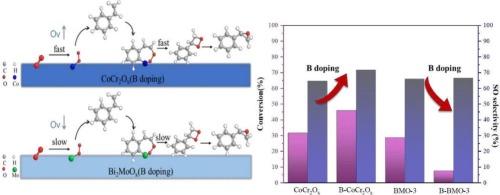硼掺杂Co-Cr和Bi-Mo复合氧化物对苯乙烯环氧化反应的影响研究:为什么会有如此大的不同?
IF 6.9
2区 材料科学
Q2 CHEMISTRY, PHYSICAL
引用次数: 0
摘要
采用共沉淀法制备了硼掺杂前后的钴铬复合氧化物(cocr2o)和铋钼复合氧化物(BMO-3),并对其在苯乙烯环氧化反应中的催化性能进行了研究。有趣的是,在硼掺杂后,它们的催化性能变化完全不同,在硼掺杂的cocr2o (b - cocr2o)催化剂上苯乙烯转化和环氧化选择性增强(从31.5 %和64.6 %提高到45.8 %和71.6 %),而在硼掺杂的BMO-3 (B-BMO-3)催化剂上苯乙烯转化和环氧化选择性减弱(从28.8 %和66.0 %降低到7.5 %和66.5 %)。对于b - cocr20ox催化剂,硼的存在诱导部分电子从Cr转移到Co态,导致Co活性态周围的电子云密度增强,从而提高Co2+的含量,从而Co活性态附近氧空位的增加增强了活化分子氧的能力,从而提高b - cocr20ox氧化物的催化性能。对于B-BMO催化剂来说,硼的存在使部分电子从Bi向Mo转移,导致电子云密度降低,Bi活性物质周围的氧空位减少,最终导致Bi活性物质附近氧空位减少,导致活性氧的生成减少,从而导致催化性能减弱。本文章由计算机程序翻译,如有差异,请以英文原文为准。


Study on the effects of boron doping Co-Cr and Bi-Mo composite oxides on styrene epoxidation: Why is it so different?
Cobalt-chromium (CoCr2Ox) and bismuth-molybdenum composite oxides (BMO-3) before and after boron-doping are prepared by co-precipitation and their catalytic performance on styrene epoxidation were studied, respectively. Interestingly, their changes in catalytic performance are completely different after boron doping, styrene conversion and epoxidation selectivity on boron-doped CoCr2Ox (B-CoCr2Ox) catalyst was enhanced (from 31.5 % and 64.6 % to 45.8 % and 71.6 %) while that of on boron-doped BMO-3 (B-BMO-3) catalyst was weakened (from 28.8 % and 66.0 % to 7.5 % and 66.5 %). For B-CoCr2Ox catalyst, the presence of boron induced some electrons to be transferred from Cr to Co species, resulting in enhanced electron cloud density around Co active species, and then the content of Co2+ species was improved, as a result, the increased oxygen vacancies near Co active species enhanced the ability to activate molecular oxygen, and then the catalytic performance of B-CoCr2Ox oxide was improved. For B-BMO-3 catalyst, the presence of boron pushes some electrons from Bi to Mo species, resulting in a lower electron cloud density and fewer oxygen vacancies around the Bi active species, finally, the reduction of oxygen vacancies near the Bi active species reduces the production of reactive oxygen species and then the catalytic performance is weakened.
求助全文
通过发布文献求助,成功后即可免费获取论文全文。
去求助
来源期刊

Applied Surface Science
工程技术-材料科学:膜
CiteScore
12.50
自引率
7.50%
发文量
3393
审稿时长
67 days
期刊介绍:
Applied Surface Science covers topics contributing to a better understanding of surfaces, interfaces, nanostructures and their applications. The journal is concerned with scientific research on the atomic and molecular level of material properties determined with specific surface analytical techniques and/or computational methods, as well as the processing of such structures.
 求助内容:
求助内容: 应助结果提醒方式:
应助结果提醒方式:


